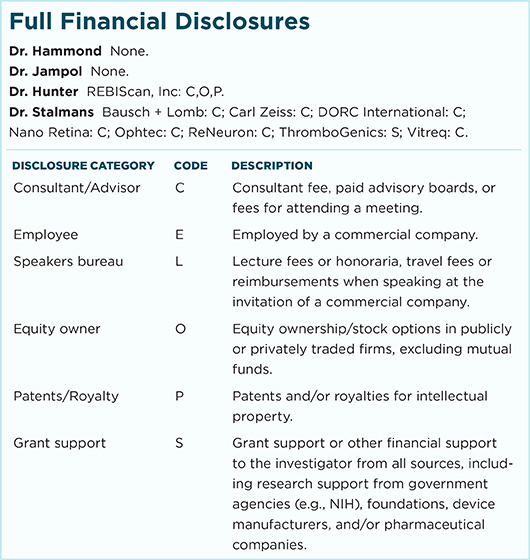Download PDF
With assistance from an ophthalmic surgical robot, Belgian researchers have successfully injected a thrombolytic drug directly into a patient’s occluded retinal vein, dissolving the clot and reversing the patient’s sight impairment from macular edema.
Researchers from the Catholic University of Leuven and University Hospitals Leuven, in Leuven, Belgium, announced this first successful reversal of retinal vein occlusion (RVO) in a January press release.1 The procedure, called retinal vein cannulation, was the first of 6 surgeries planned in a phase 1 clinical trial of robot-assisted treatment of RVO with the drug ocriplasmin, they said.
Synergy between surgeon and robot. The yet-unnamed robot, which took 7 years to create, looks like a smaller, refined version of the robot arms used in automotive factories. It is designed not to replace the surgeon’s hand but rather to overcome the human hand’s limitations when trying to insert a 30-μm needle tip into a 100-μm retinal vein, said Peter Stalmans, MD, PhD, the vitreoretinal surgeon on the research team.
“The principle of the robot is that it eliminates the tremor of your hands. To the surgeon it feels as if you are moving the instrument into a very thick gel. So you can make very gentle, slow motions with no sudden movements,” Dr. Stalmans said.
“Then, when the needle is inserted into the vessel, you release the foot pedal and the robot will lock in place. So the surgeon can let go of the instrument and leave it there for several minutes while the ocriplasmin is being infused,” he said.
Dr. Stalmans noted that the robot system’s design for “co-manipulation” gives it a familiar feel. “The major difference from other surgical robots—for instance, the da Vinci—is that in this case there is co-manipulation with the robot,” he said. “You are holding the instrument just as you would be doing in any type of ocular surgery. It is not operated with a joystick.”
Initial patient results. Feasibility and safety are the primary endpoints of the ongoing study of RVO treatment, but the potential for clinical efficacy was apparent with the first patient, Dr. Stalmans said.
“The patient had only hand movements [vision] before the procedure, and to our surprise, after 2 weeks the patient had 0.16 visual acuity [20/125]. Before surgery, his macula was about 1,500 μm thick, and the edema was completely gone after 2 weeks. That was really, really a surprise to us,” he said.
As of early March, 2 more patients had undergone retinal vein cannulation (results not available at time of press). No adverse events related to the procedure were recorded, Dr. Stalmans said.
What about arteries? Dr. Stalmans said that other ophthalmologists commonly ask him if robot-assisted retinal surgery might be used for treating central retinal artery occlusion. He doesn’t consider that feasible, for 2 reasons. First, it would be difficult to treat an arterial occlusion quickly enough to protect the retina, he said.
Second, occluded arteries are too small: “In a vein occlusion the vessels swell, which makes it easier for us to do the cannulation. But in an artery occlusion, the vessels shrink. And using the current technology it’s impossible in a shrunken artery to insert a needle. It is already very difficult in a vein, let alone in an artery,” he said.
Possible applications. However, the robot might be a good fit for other intraocular procedures, including targeted delivery of chemotherapy to tumors, treatment of arteriovenous malformations, and subretinal injections, such as for gene therapy, he said.
For now, the possibility of using the robot to treat RVO is exciting, he said. “The robotic device enables us to treat the cause of the thrombosis in the retina for the first time. I am, therefore, looking forward to what is next. If we succeed, we will literally be able to make blind people see again.”
—Linda Roach
___________________________
1 Press release, Jan. 26, 2017. www.kuleuven.be/english/news/2017/surgical-eye-robot-performs-precision-injection-in-patient-with-retinal-vein-occlusion. [Also includes images and surgical video.]
___________________________
Relevant financial disclosures—Dr. Stalmans: ThromboGenics: S.
For full disclosures and disclosure key, see below.

More from this month’s News in Review